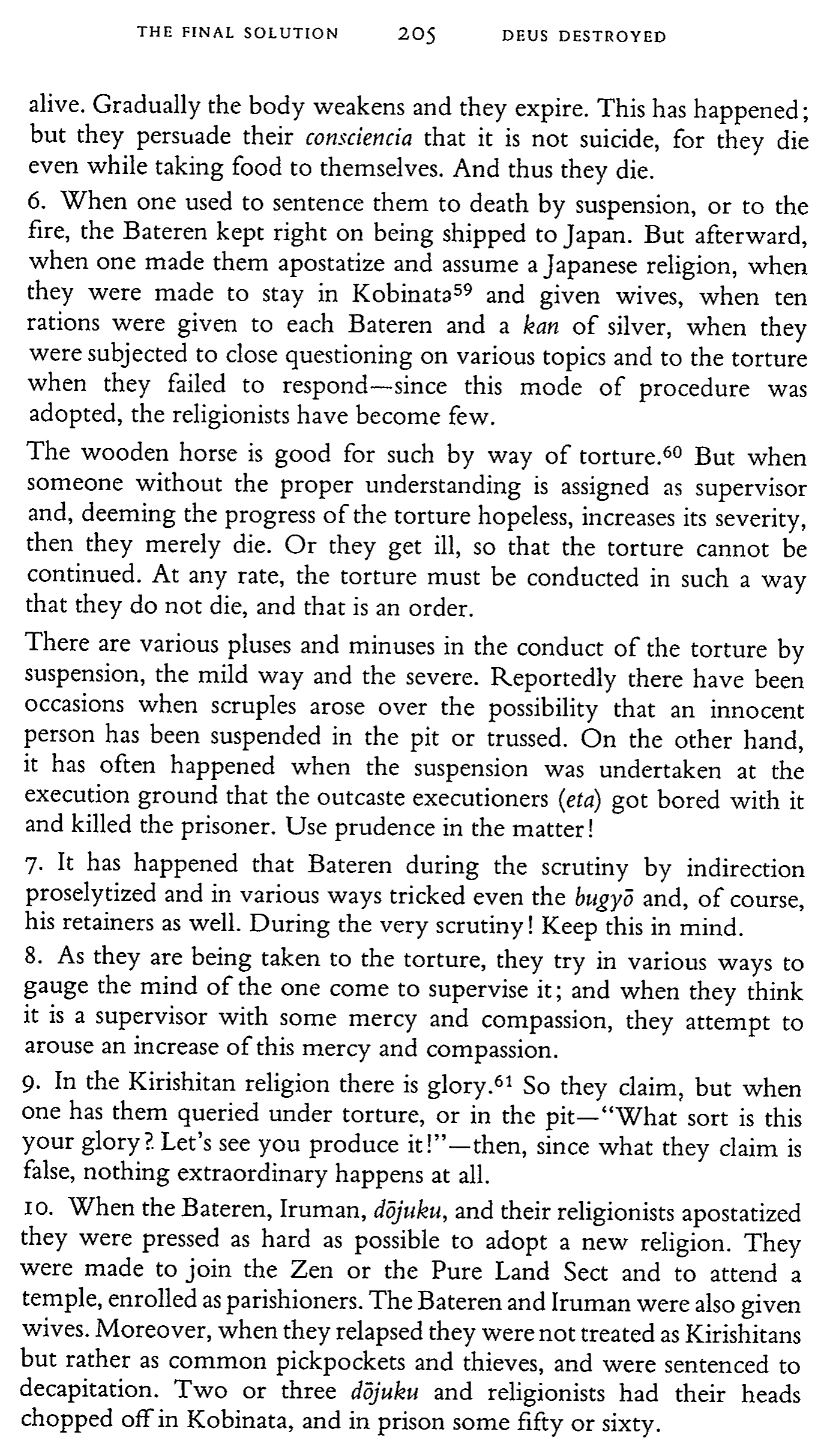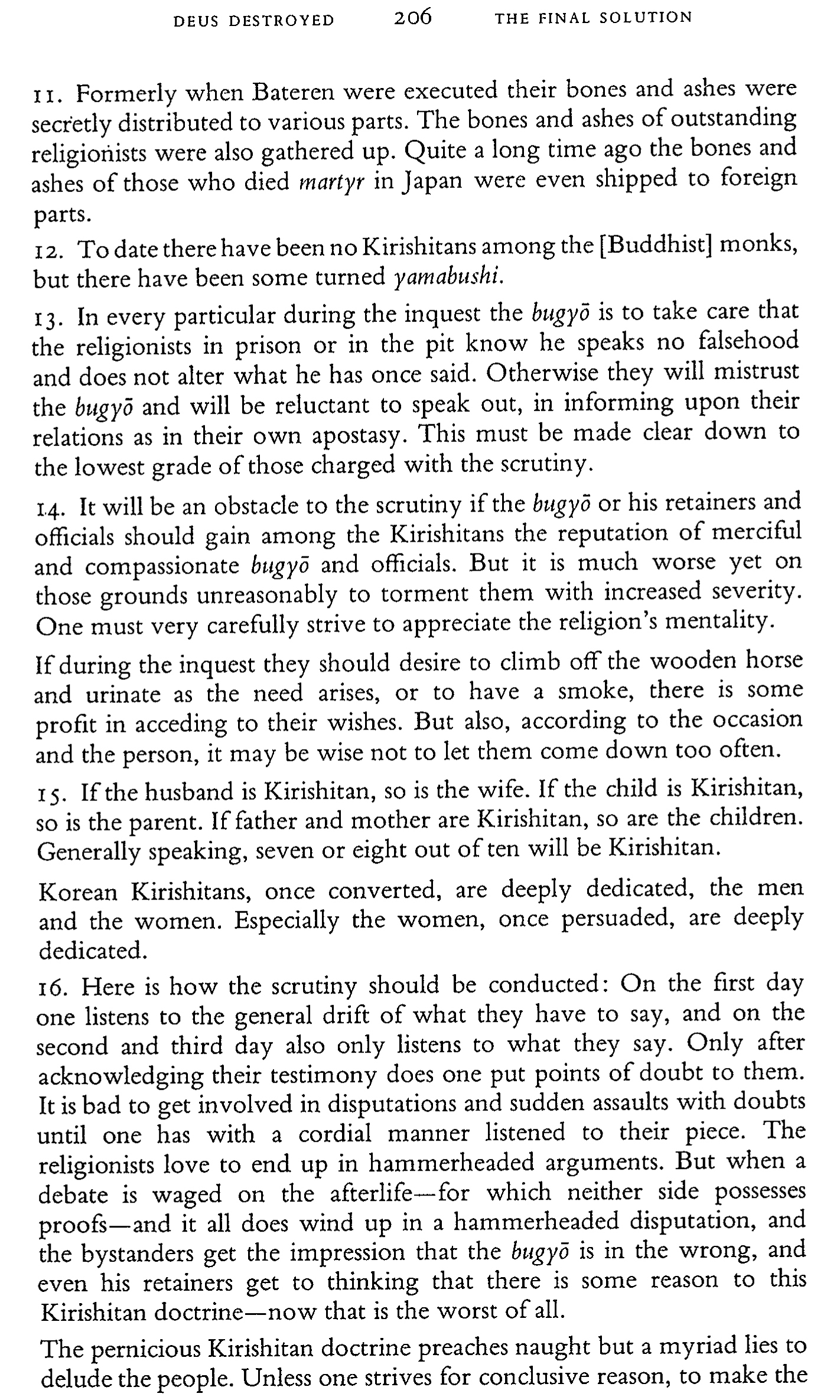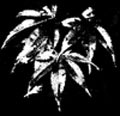|
1640-1658: Methods of the Christian Convert Inquisition
Described by Inoue Masashige in the Kirishito-ki
井上政重 - INOUE MASASHIGE
契利斯督記 - KIRISHITO-KI
English Translation by George Elison, 1973, 1988
German Translation by Gustav Voss & Hubert Cieslik, 1940
INTRODUCTION:
In 1640, the first 'Shūmon aratame-yaku' national sects inspection chief inquisitor was appointed by Tokugawa Iemitsu Shōgun who ruled Japan from 1623 to 1651:
Inoue Chikugo-no-Kami Masashige, more commonly known but as Inoue Masashige,
井上筑後の守政重, 1585-1661,
served in high-ranking government office, leading the nationwide 'Shūmon aratame-yaku' anti-Christian inquisition organization, from 1640 till 1658,
while most efficiently supervising the nationwide persecution and almost total elimination of all Christian, Catholic converts
that was most efficiently maintained in Japan till shortly before the end of the Tokugawa Period, in 1859.
Inoue's title appears to have been that of 'shūnin",
就任,
"Official Inspector".
KIRISHITO-KI - An anti-Christian inquisitor's manual by Inoue Masashige
Inoue Chikugo-no-Kami Masashige wrote detailed instructions for the persecutions of Christian converts
during his tenure as first chief religious sects inquisitor, 1640-1658, appointed by the Tokugawa Shōgun Iemitsu, who hated Christianity, the Catholic missionaries
and Japan's Christian converts as a whole, with no limit.
That detailed "manual for inquisitors" hunting down and exterminating Christian converts was created for internal use only and first compiled under Inoue's successor in office,
Hōjō Awa no Kami Ujinaga,
北条阿波の守氏長, no dates, yet.
George Elison, in his monumental work "Deus Destroyed", 1988 (1973), introduces Document VII that focuses on methods of investigation and punishment like this,
on page 204:
"Information on Christianity and its diffusion in Japan is one part of the contents of Kirishito-ki.
But the most significant portions of this manual are those which deal with the methods of the shūmon-aratame yaku.
The greater part of the documents was compiled during the early years of tenure of the second Inquisitor, Hōjō Awano Kami Ujinaga, who succeeded Inoue in 1658.
Inoue departed the office in circumstances that were less than glorious.
His prosecution of the anti-Christian policy had for almost twenty years seemed successful.
But the seed had not really been extirpated: in 1657, 608 Christians were discovered in Ōmura; 411 of these proved unregenerate and were executed.
The incident may well have contributed to Inoue's resignation.
The Kirishito-ki is Inoue's monument, and in the main represents his effort to initiate Hōjō Awa into his duties.
The documents were meant strictly for internal use, and not for propaganda.
As Cieslik and Voss point out [Voss & Cieslik, 1940, see bibliography below, ed.], this unquestionable measure of authenticity greatly increases their value for the historian.
The purpose and procedures of the inquisition are herein revealed in all their grim sobriety and downright terrifying banality.
The meticulous nature of the process is best illustrated in Document VII of the compendium, which deserves quotation in extenso."
Elison's translation of Document VII is here, copy-pasted from the available online PDF edition, and scannings of the book pages are presented down below:
"TO KEEP IN MIND IN THE RELIGIOUS SCRUTINY
1. At first the religionists when questioned whether they were Kirishitans
would hide nothing at all, responding that they were Kirishitans.
But these days they hide their religion as they can.
2. Old wives and women when made to tread upon the image (fumie)
of Deus get agitated and red in the face; they cast off their headdress;
their breath comes in rough gasps; sweat pours from them.
And, according to the individual, there are reportedly women who
Venerate the fumie, but in a way to remain unobserved.
3. During the religious scrutiny the native province and the place of
extended residence are to be inquired into, for reasons of consideration
whether it be a province where Bateren have not wandered or one
which they have visited and where their religion is diffused.
4. They engrave sword pommels with tiny imagem or put imagem and
Bateren bones, ashes, and suchlike inside their pillows, inside pottery and
incense boxes, or into medicinal salve. All of this has happened, so
pay attention.
5. The Kirishitan religion prohibits suicide. But during what they call
jejum they reduce their meals and when they do eat they eat but little,
eating moreover just enough of radish, turnip, or the sort to keep alive.
Gradually the body weakens and they expire. This has happened;
but they persuade their consciencia that it is not suicide, for they die
even while taking food to themselves.
And thus they die.
6. When one used to sentence them to death by suspension, or to the
fire, the Bateren kept right on being shipped to Japan. But afterward,
when one made them apostatize and assume a Japanese religion, when
they were made to stay in Kobinata and given wives, when ten
rations were given to each Bateren and a kan of silver, when they
were subjected to close questioning on various topics and to the torture
when they failed to respond - since this mode of procedure was
adopted, the religionists have become few.
The wooden horse is good for such by way of torture. But when
someone without the proper understanding is assigned as supervisor
and, deeming the progress of the torture hopeless, increases its severity,
then they merely die. Or they get ill, so that the torture cannot be
continued.
At any rate, the torture must be conducted in such a way
that they do not die, and that is an order.
There are various pluses and minuses in the conduct of the torture by
suspension, the mild way and the severe. Reportedly there have been
occasions when scruples arose over the possibility that an innocent
person has been suspended in the pit or trussed. On the other hand,
it has often happened when the suspension was undertaken at the
execution ground that the outcaste executioners (eta) got bored with it
and killed the prisoner.
Use prudence in the matter!
7. It has happened that Bateren during the scrutiny by indirection
proselytized and in various ways tricked even the bugyō and, of course,
his retainers as well.
During the very scrutiny! Keep this in mind.
8. As they are being taken to the torture, they try in various ways to
gauge the mind of the one come to supervise it; and when they think
it is a supervisor with some mercy and compassion, they attempt to
arouse an increase of this mercy and compassion.
9. In the Kirishitan religion there is glory. So they claim, but when
one has them queried under torture, or in the pit - "What sort is this
your glory?. Let's see you produce it!" - then, since what they claim is
false, nothing extraordinary happens at all.
10. When the Bateren, Iruman, dōjuku, and their religionists apostatized
they were pressed as hard as possible to adopt a new religion. They
were made to join the Zen or the Pure Land Sect and to attend a
temple, enrolled as parishioners.
The Bateren and Iruman were also given wives.
Moreover, when they relapsed they were not treated as Kirishitans
but rather as common pickpockets and thieves, and were sentenced to
decapitation. Two or three dōjuku and religionists had their heads
chopped off in Kobinata, and in prison some fifty or sixty.
11. Formerly when Bateren were executed their bones and ashes were
secretly distributed to various parts. The bones and ashes of outstanding
religionists were also gathered up.
Quite a long time ago the bones and ashes of those who died martyr in Japan were even shipped to foreign parts.
12. To date there have been no Kirishitans among the [Buddhist] monks,
but there have been some turned yamabushi.
13. In every particular during the inquest the bugyō is to take care that
the religionists in prison or in the pit know he speaks no falsehood
and does not alter what he has once said. Otherwise they will mistrust
the bugyō and will be reluctant to speak out, in informing upon their
relations as in their own apostasy. This must be made clear down to
the lowest grade of those charged with the scrutiny.
14. It will be an obstacle to the scrutiny if the bugyō or his retainers and
officials should gain among the Kirishitans the reputation of merciful
and compassionate bugyō and officials. But it is much worse yet on
those grounds unreasonably to torment them with increased severity.
One must very carefully strive to appreciate the religion's mentality.
If during the inquest they should desire to climb off the wooden horse
and urinate as the need arises, or to have a smoke, there is some
profit in acceding to their wishes.
But also, according to the occasion and the person, it may be wise not to let them come down too often.
15. If the husband is Kirishitan, so is the wife. If the child is Kirishitan,
so is the parent. If father and mother are Kirishitan, so are the children.
Generally speaking, seven or eight out of ten will be Kirishitan.
Korean Kirishitans, once converted, are deeply dedicated, the men
and the women. Especially the women, once persuaded, are deeply
dedicated.
16. Here is how the scrutiny should be conducted: On the first day
one listens to the general drift of what they have to say, and on the
second and third day also only listens to what they say. Only after
acknowledging their testimony does one put points of doubt to them.
It is bad to get involved in disputations and sudden assaults with doubts
until one has with a cordial manner listened to their piece. The
religionists love to end up in hammerheaded arguments. But when a
debate is waged on the afterlife-for which neither side possesses
proofs-and it all does wind up in a hammerheaded disputation, and
the bystanders get the impression that the bugyō is in the wrong, and
even his retainers get to thinking that there is some reason to this
Kirishitan doctrine - now that is the worst of all.
The pernicious Kirishitan doctrine preaches naught but a myriad lies to
delude the people. Unless one strives for conclusive reason, to make the
people understand the pravity, the retainers down to the lowest rank
of those involved in the scrutiny will deem [the Kirishitan doctrine)
admirable.
17. The Bateren teach their Kirishitan religionists about the scrutiny that
the bugyō is a man of wisdom and the ability to distinguish right
from wrong; but when he undertakes the religious scrutiny his wisdom
is beclouded and his eloquence paralyzed. But the religionists, though
they be neither eloquent nor intelligent, will for the glory and through
the special grace of God develop wisdom and clearest intelligence.
Thus they teach, and the religionists size up their situation according to this teaching.
Then there are those who, even at the moment of confrontation with
their informer at the bugyō office, set their clothes in order and in an
ever so polite a manner show their respect for the bugyō and refrain
from bad words even toward the informer. That is because they have
been taught that when the time comes for them to ascend into heaven
they will first be called before the bugyō. They feel no hate even
toward the one who has informed against them. For they are taught
that if they should consider him their enemy, then the road to heaven
would be barred to them.
18. Among the territorial lords there are those whose prosecution of
Kirishitans is conducted well, and those who do it badly. They hide
in provinces where the religious prosecution is badly conceived. Since
in that case they find it easy to blend into the populace, in such
provinces there unfailingly are Kirishitans.
The greatest care must be exercised during the test in the parish temple.
Even the priests are fooled. Heretofore the Kirishitans have not had their
corpses cremated. They have put the cadaver into a tub in the home
and, placing inside the tub a cruz made of planks, they have tied up
the top of the tub tightly and buried it in the ground. It is true that
in places with a dearth of firewood the Buddhists also use interment;
but one must be wary in such places also. Discovery of a Kirishitan has
sometimes resulted when a corpse was exhumed and the tub's inside
scrutinized.
There are provinces where peasants, townsmen, and artisans are made
to take a Japanese and a Southern Barbarian oath and to register in
a temple, and after that are left alone with no test for another year
or two. To such negligent places Kirishitans unfailingly come to hide.
The instances are many."
George Elison comments:
Inoue had cynically stated that "it is bad to take a liking to
torture and to depend upon it," and he had insisted that "one
must carefully consider the criminal's mentality."
But the intrusions into the criminal's mentality were made possible only
by the ultimate reliance upon torture. The jarring switch from
the soft and pliable manner to the harsh and threatening was in
the classical interrogator's mode.
The assaults with Fabianesque rhetoric further took advantage of disoriented minds. And finally
the pedant demanded something in writing. The consummation
of the dismal self-betrayal was the signed confession.
This is the sum of lnoue's intellectuality.
Inoue Chikugo was an intellectual in the same sense as was
Adolf Eichmann. His diabolism was that of the farceur drawn to
the query of cadavers.
His method was quite successful.
What is more, it strikes one as being quite modern."




George Elison's translation of Inoue Masashige's Document VII regarding investigation, prosecution, and punishment of Christian converts.
Link to an online edition of the 'Kirishito-ki' c/o the Library of Tokyo University
GUSTAV VOSS & HUBERT CIESLIK's German Translation, scanned from the original book of theirs that was printed in 1940:






Gustav Voss and Hubert Cieslik's German translation of 'Document VII' of the 'Kirishito-ki', pages 58 to 62
RECOMMENDED READINGS:
Masaharu Anesaki: History of Japanese Religion:
with special reference to the social and moral life of the nation
C.E. Tuttle Co., Rutland, Vermont & Tokyo, 1963.
First publ. by Kegan Paul, Trench, Trubner & Co., London, 1930.
Link to online PDF file:
https://archive.org/details/in.ernet.dli.2015.125609/page/n7/mode/2up
Masaharu Anesaki: "Prosecutions of Kirishitans after the Shimabara Insurrection".
In: Monumenta Nipponica, Vol. 1, No. 2, July, 1938, pp. 293-300 (8 pages)
Link to online PDF file:
https://www.jstor.org/stable/2382669?seq=1
Robert Neelly Bellah: Tokugawa Religion: The cultural roots of modern Japan.
Free Press, 1985.
Renata Cabral Bernabé: Religiosity and Underground Life:
Christianity among the Japanese during the Persecution."
In: Bulletin of Portuguese/Japanese Studies, 2nd Series, Volume 5,
December 2022. Link to PDF file:
https://www.academia.edu/94733401/Religiosity_and_Underground_Life_Christianity_among_the_Japanese_during_the_Persecution
Leonard Blussé: "The Grand Inquisitor Inoue Chikugo no Kami Masashige,
Spin Doctor of the Tokugawa Bakufu."
Bulletin of Portuguese - Japanese Studies, núm. 7, december, 2003, pp. 23-43.
Universidade Nova de Lisboa, Lisboa, Portugal.
Link to PDF file: https://www.redalyc.org/pdf/361/36100702.pdf
C.R. Boxer: The Christian Century in Japan, 1549-1650.
Carcarnet Press Limited, Manchester, 1993.
First published in 1951 by The University of
California Press & the Cambridge University Press.
Link to PDF file:
https://ia801603.us.archive.org/9/items/THECHRISTIANCENTURYINJAPAN15491650CRBOXER/THE%20CHRISTIAN%20CENTURY%20IN%20JAPAN%201549-1650%20C%20R%20%20BOXER.pdf
Frank Brinkley, ass. by Kikuchi Dairoku: A History of the Japanese People
from the Earliest Times to the End of the Meiji Era.
The Encyclopædia Britannica Co., New York & London, c. 1915.
Link to PDF file:
https://archive.org/details/historyofjapanes00briniala
Hubert S.J. Cieslik: "The Great Martyrdom in Edo, 1623:
Its Causes, Course, Consequences."
In: Monumenta Nipponica X, 1954, pp. 1-44.
Link to PDF file: https://www.jstor.org/stable/2382790
Jonathan Clements: Christ's Samurai: The True Story of the Shimabara Rebellion.
Published by Robinson, London, 2016.
Michael S.J. Cooper: They Came to Japan. An Anthology of European Reports
on Japan, 1543-1640.
University of California Press, Berkeley, Los Angeles, 1965.
Link to PDF file: https://archive.org/details/theycametojapan0000coop
Jean Crasset: The History of the Church of Japan.
Written originally in French by Monsieur L'Abbe de T.
and now translated into English by N.N. 2 volumes, 2010.
Originally published in 1705-1707.
John Dougill: In Search of Japan's Hidden Christians.
A Story of Suppression, Secrecy and Survival.
Tuttle Publishing, 2012, 2015.
Shūsaku Endō / Endō Shūsaku: Silence.
Original Japanese novel published in 1966.
Peter Owen Publishers, London, 2003, 2007 & 2009.
English translation first published in 1969
by Sophia University Press. Tokyo,
Copyright © by William Johnston, 1969.
Movie by Martin Scorsése published in 2016.
Edward Hagemann: "The Persecution of the Christians in Japan
in the Middle of the Seventeenth Century."
Publ. in Pacific Historical Review
Vol. 11, No. 2, June, 1942, pp. 151-160 (10 pages)
Made available byy: University of California Press
Link to online PDF file: https://www.jstor.org/stable/3633765
Nam-lin Hur: "Anti-Christianity and Funerary Buddhism in Tokugawa Japan."
PDF-file, The University of British Columbia, January 2005.
Download link: https://www.researchgate.net/publication/279504647_Anti-Christianity_and_Funerary_Buddhism_in_Tokugawa_Japan
Nam-lin Hur: Death and Social Order in Tokugawa Japan:
Buddhism, Anti-Christianity, and the Danka System.
Harvard East Asian Monographs 282, Harvard University Asia
Center, Cambridge, Mass. & London, 2007, 550 pages.
Joseph Jennes: History of the Catholic Church in Japan,
From its Beginnings to the Early Meiji Era (1549-1873).
A Short Handbook. 1973.
Fujii Joji: Edo jidai no o-fure.
"Public Proclamations in Edo Period Japan."
Yamakawa Shuppansha, Tokyo, 2013.
Tanabe Hisao: Nihon no ongaku.
Bunka Kenkyūsha, 1947.
Tanabe Hisao: Nihon no ongaku.
Bunka Kenkyūsha, 1954.
Stephen Turnbull: The Kakure Kirishitan of Japan: A Study of their Development,
Beliefs and Rituals to the Present Day.
Routledge, New York, 2013 (1998).
Gustav Voss & Hubert Cieslik (trsls.): Kirishito-ki und Sayō-yoroku:
Japanische Dokumente zur Missionsgeschichte
des 17. Jahrhunderts (English).
Sophia University, Tokyo, 1940, 229 pages.
|

Momiji
|











